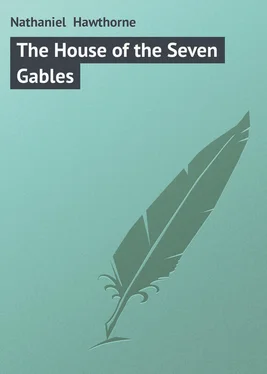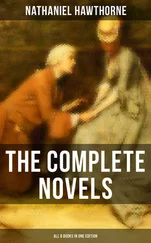Nathaniel Hawthorne - The House of the Seven Gables
Здесь есть возможность читать онлайн «Nathaniel Hawthorne - The House of the Seven Gables» — ознакомительный отрывок электронной книги совершенно бесплатно, а после прочтения отрывка купить полную версию. В некоторых случаях можно слушать аудио, скачать через торрент в формате fb2 и присутствует краткое содержание. Год выпуска: 0101, Жанр: foreign_antique, foreign_prose, на английском языке. Описание произведения, (предисловие) а так же отзывы посетителей доступны на портале библиотеки ЛибКат.
- Название:The House of the Seven Gables
- Автор:
- Жанр:
- Год:0101
- ISBN:нет данных
- Рейтинг книги:3 / 5. Голосов: 1
-
Избранное:Добавить в избранное
- Отзывы:
-
Ваша оценка:
- 60
- 1
- 2
- 3
- 4
- 5
The House of the Seven Gables: краткое содержание, описание и аннотация
Предлагаем к чтению аннотацию, описание, краткое содержание или предисловие (зависит от того, что написал сам автор книги «The House of the Seven Gables»). Если вы не нашли необходимую информацию о книге — напишите в комментариях, мы постараемся отыскать её.
The House of the Seven Gables — читать онлайн ознакомительный отрывок
Ниже представлен текст книги, разбитый по страницам. Система сохранения места последней прочитанной страницы, позволяет с удобством читать онлайн бесплатно книгу «The House of the Seven Gables», без необходимости каждый раз заново искать на чём Вы остановились. Поставьте закладку, и сможете в любой момент перейти на страницу, на которой закончили чтение.
Интервал:
Закладка:
NATHANIEL HAWTHORNE
THE HOUSE OF THE SEVEN GABLES
Introductory Note.
In September of the year during the February of which Hawthorne had completed "The Scarlet Letter," he began "The House of the Seven Gables." Meanwhile, he had removed from Salem to Lenox, in Berkshire County, Massachusetts, where he occupied with his family a small red wooden house, still standing at the date of this edition, near the Stockbridge Bowl.
"I sha'n't have the new story ready by November," he explained to his publisher, on the 1st of October, "for I am never good for anything in the literary way till after the first autumnal frost, which has somewhat such an effect on my imagination that it does on the foliage here about me-multiplying and brightening its hues." But by vigorous application he was able to complete the new work about the middle of the January following.
Since research has disclosed the manner in which the romance is interwoven with incidents from the history of the Hawthorne family, "The House of the Seven Gables" has acquired an interest apart from that by which it first appealed to the public. John Hathorne (as the name was then spelled), the great-grandfather of Nathaniel Hawthorne, was a magistrate at Salem in the latter part of the seventeenth century, and officiated at the famous trials for witchcraft held there. It is of record that he used peculiar severity towards a certain woman who was among the accused; and the husband of this woman prophesied that God would take revenge upon his wife's persecutors. This circumstance doubtless furnished a hint for that piece of tradition in the book which represents a Pyncheon of a former generation as having persecuted one Maule, who declared that God would give his enemy "blood to drink." It became a conviction with the Hawthorne family that a curse had been pronounced upon its members, which continued in force in the time of the romancer; a conviction perhaps derived from the recorded prophecy of the injured woman's husband, just mentioned; and, here again, we have a correspondence with Maule's malediction in the story. Furthermore, there occurs in the "American Note-Books" (August 27, 1837), a reminiscence of the author's family, to the following effect. Philip English, a character well-known in early Salem annals, was among those who suffered from John Hathorne's magisterial harshness, and he maintained in consequence a lasting feud with the old Puritan official. But at his death English left daughters, one of whom is said to have married the son of Justice John Hathorne, whom English had declared he would never forgive. It is scarcely necessary to point out how clearly this foreshadows the final union of those hereditary foes, the Pyncheons and Maules, through the marriage of Phoebe and Holgrave. The romance, however, describes the Maules as possessing some of the traits known to have been characteristic of the Hawthornes: for example, "so long as any of the race were to be found, they had been marked out from other men—not strikingly, nor as with a sharp line, but with an effect that was felt rather than spoken of—by an hereditary characteristic of reserve." Thus, while the general suggestion of the Hawthorne line and its fortunes was followed in the romance, the Pyncheons taking the place of the author's family, certain distinguishing marks of the Hawthornes were assigned to the imaginary Maule posterity.
There are one or two other points which indicate Hawthorne's method of basing his compositions, the result in the main of pure invention, on the solid ground of particular facts. Allusion is made, in the first chapter of the "Seven Gables," to a grant of lands in Waldo County, Maine, owned by the Pyncheon family. In the "American Note-Books" there is an entry, dated August 12, 1837, which speaks of the Revolutionary general, Knox, and his land-grant in Waldo County, by virtue of which the owner had hoped to establish an estate on the English plan, with a tenantry to make it profitable for him. An incident of much greater importance in the story is the supposed murder of one of the Pyncheons by his nephew, to whom we are introduced as Clifford Pyncheon. In all probability Hawthorne connected with this, in his mind, the murder of Mr. White, a wealthy gentleman of Salem, killed by a man whom his nephew had hired. This took place a few years after Hawthorne's graduation from college, and was one of the celebrated cases of the day, Daniel Webster taking part prominently in the trial. But it should be observed here that such resemblances as these between sundry elements in the work of Hawthorne's fancy and details of reality are only fragmentary, and are rearranged to suit the author's purposes.
In the same way he has made his description of Hepzibah Pyncheon's seven-gabled mansion conform so nearly to several old dwellings formerly or still extant in Salem, that strenuous efforts have been made to fix upon some one of them as the veritable edifice of the romance. A paragraph in the opening chapter has perhaps assisted this delusion that there must have been a single original House of the Seven Gables, framed by flesh-and-blood carpenters; for it runs thus:—
"Familiar as it stands in the writer's recollection—for it has been an object of curiosity with him from boyhood, both as a specimen of the best and stateliest architecture of a long-past epoch, and as the scene of events more full of interest perhaps than those of a gray feudal castle—familiar as it stands, in its rusty old age, it is therefore only the more difficult to imagine the bright novelty with which it first caught the sunshine."
Hundreds of pilgrims annually visit a house in Salem, belonging to one branch of the Ingersoll family of that place, which is stoutly maintained to have been the model for Hawthorne's visionary dwelling. Others have supposed that the now vanished house of the identical Philip English, whose blood, as we have already noticed, became mingled with that of the Hawthornes, supplied the pattern; and still a third building, known as the Curwen mansion, has been declared the only genuine establishment. Notwithstanding persistent popular belief, the authenticity of all these must positively be denied; although it is possible that isolated reminiscences of all three may have blended with the ideal image in the mind of Hawthorne. He, it will be seen, remarks in the Preface, alluding to himself in the third person, that he trusts not to be condemned for "laying out a street that infringes upon nobody's private rights... and building a house of materials long in use for constructing castles in the air." More than this, he stated to persons still living that the house of the romance was not copied from any actual edifice, but was simply a general reproduction of a style of architecture belonging to colonial days, examples of which survived into the period of his youth, but have since been radically modified or destroyed. Here, as elsewhere, he exercised the liberty of a creative mind to heighten the probability of his pictures without confining himself to a literal description of something he had seen.
While Hawthorne remained at Lenox, and during the composition of this romance, various other literary personages settled or stayed for a time in the vicinity; among them, Herman Melville, whose intercourse Hawthorne greatly enjoyed, Henry James, Sr., Doctor Holmes, J. T. Headley, James Russell Lowell, Edwin P. Whipple, Frederika Bremer, and J. T. Fields; so that there was no lack of intellectual society in the midst of the beautiful and inspiring mountain scenery of the place. "In the afternoons, nowadays," he records, shortly before beginning the work, "this valley in which I dwell seems like a vast basin filled with golden Sunshine as with wine;" and, happy in the companionship of his wife and their three children, he led a simple, refined, idyllic life, despite the restrictions of a scanty and uncertain income. A letter written by Mrs. Hawthorne, at this time, to a member of her family, gives incidentally a glimpse of the scene, which may properly find a place here. She says: "I delight to think that you also can look forth, as I do now, upon a broad valley and a fine amphitheater of hills, and are about to watch the stately ceremony of the sunset from your piazza. But you have not this lovely lake, nor, I suppose, the delicate purple mist which folds these slumbering mountains in airy veils. Mr. Hawthorne has been lying down in the sun shine, slightly fleckered with the shadows of a tree, and Una and Julian have been making him look like the mighty Pan, by covering his chin and breast with long grass-blades, that looked like a verdant and venerable beard." The pleasantness and peace of his surroundings and of his modest home, in Lenox, may be taken into account as harmonizing with the mellow serenity of the romance then produced. Of the work, when it appeared in the early spring of 1851, he wrote to Horatio Bridge these words, now published for the first time:—
Читать дальшеИнтервал:
Закладка:
Похожие книги на «The House of the Seven Gables»
Представляем Вашему вниманию похожие книги на «The House of the Seven Gables» списком для выбора. Мы отобрали схожую по названию и смыслу литературу в надежде предоставить читателям больше вариантов отыскать новые, интересные, ещё непрочитанные произведения.
Обсуждение, отзывы о книге «The House of the Seven Gables» и просто собственные мнения читателей. Оставьте ваши комментарии, напишите, что Вы думаете о произведении, его смысле или главных героях. Укажите что конкретно понравилось, а что нет, и почему Вы так считаете.












